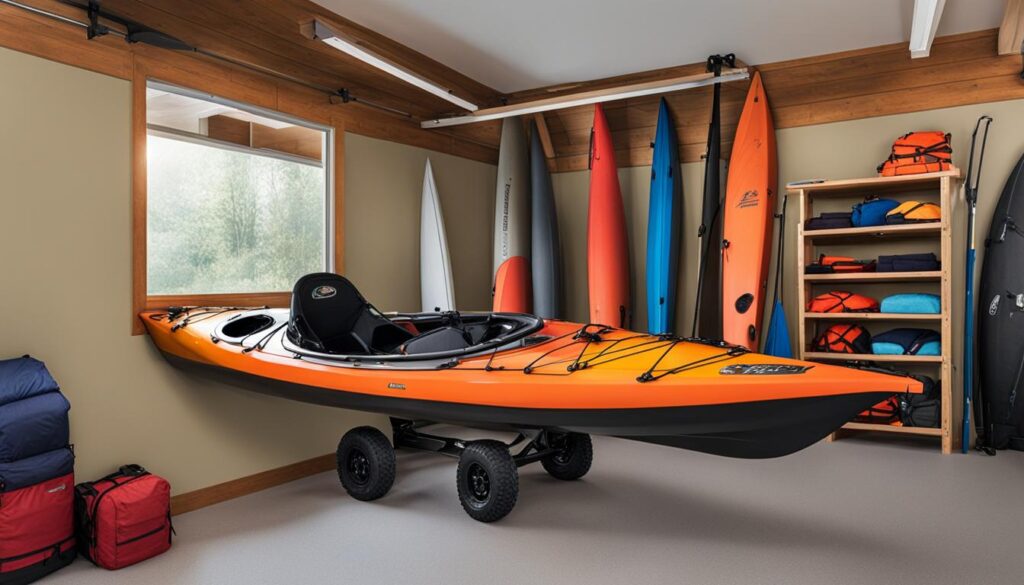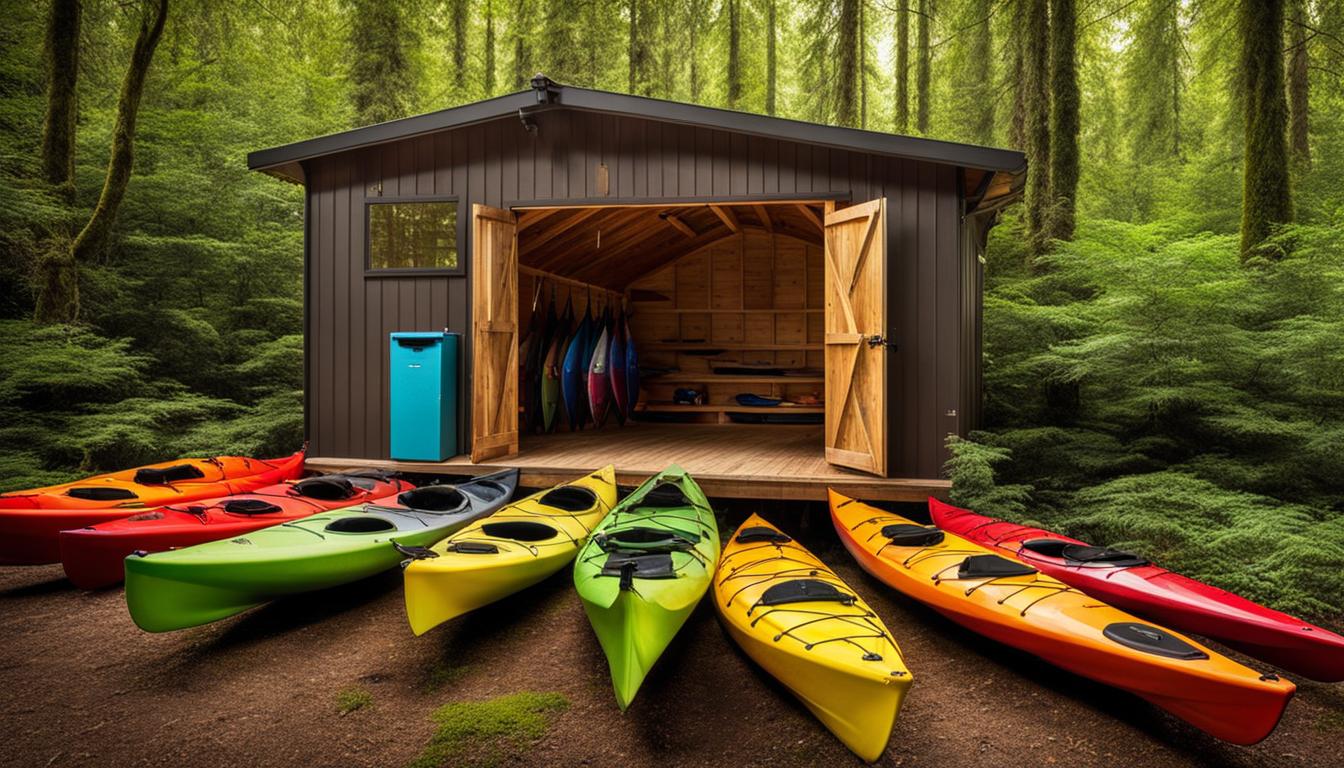Storing your kayak correctly is essential for ensuring its longevity and keeping it in good condition. There are pros and cons to both indoor and outdoor storage options. Indoor storage, such as in a garage or shed, provides protection from the elements and helps prevent theft. It is important to keep the kayak away from other objects to avoid damage. Additionally, keeping the kayak out of direct sunlight will prevent discoloration and aging. For indoor storage, options like storage racks or suspension systems can be used. On the other hand, outdoor storage can be a last resort option if there is no indoor space available. Shaded outdoor areas, such as back porches or patios, can provide protection from the sun, wind, and extreme heat. Using storage racks or suspension cords, along with loosely draping a tarp over the kayak, can help protect it from the elements. Overall, the ideal storage option will depend on the available space and specific needs of the kayak owner.
Key Takeaways:
- Indoor storage offers protection from the elements and helps prevent theft.
- Keep the kayak away from other objects to avoid damage.
- Direct sunlight can cause discoloration and aging.
- Outdoor storage in shaded areas can protect the kayak from sun, wind, and extreme heat.
- Storage racks, suspension systems, and tarps can be used for both indoor and outdoor storage.
Kayak Storage Solutions for Small Spaces
When you have limited space, finding suitable storage solutions for your kayak can be a challenge. Fortunately, there are several options available that can help you maximize space and keep your kayak secure.
One popular option is to use indoor kayak rack plans. These racks can be attached to the wall or ceiling, providing a convenient storage solution that keeps your kayak off the ground. By utilizing vertical space, you can save valuable floor space in small areas. The racks should be designed to provide proper support and weight distribution to avoid any damage to your kayak.
Another space-saving option is to use kayak storage hooks. These hooks can be easily installed on a wall or other surface, allowing you to suspend your kayak. By lifting the kayak off the ground, you can free up floor space for other items. Just make sure that the hook you choose is strong enough to support the weight of your kayak.
Ultimately, the ideal storage solution for small spaces will depend on the layout of your area and your specific needs. Assess your available space and consider factors such as ease of access, security, and weight capacity when choosing a storage solution for your kayak.

| Storage Solution | Key Features |
|---|---|
| Indoor Kayak Rack | – Attaches to the wall or ceiling – Maximizes vertical space – Provides secure storage |
| Kayak Storage Hooks | – Easily installed on walls or surfaces – Saves floor space – Must be strong enough to support the weight of the kayak |
Weatherproof Outdoor Kayak Storage Options
When it comes to storing your kayak outdoors, protecting it from the elements is crucial. The best outdoor kayak storage options are designed to be weatherproof, ensuring your kayak stays in optimal condition for years to come.
One option to consider is investing in a storage shed specifically designed for kayaks. These sheds provide a secure and waterproof space to store your kayak, shielding it from rain, snow, and harmful UV radiation. With a dedicated kayak storage shed, you can have peace of mind knowing your kayak is protected from the harshest weather conditions.
If you’re short on space, a kayak storage hoist system can be a great solution. This system allows you to lift and suspend your kayak from the ceiling or another sturdy structure, saving valuable floor space. By keeping your kayak off the ground, you minimize the risk of damage and maximize the available storage area.
Another option to consider is using kayak storage brackets. These brackets can be mounted on a wall or vertical surface, providing a stable and secure way to store your kayak. By utilizing brackets, you can keep your kayak off the ground and reduce the risk of any accidental damage.
FAQ
What are the pros and cons of indoor kayak storage?
Indoor storage provides protection from the elements and helps prevent theft. However, it is important to keep the kayak away from other objects to avoid damage.
How can I protect my kayak from discoloration and aging when stored indoors?
Keeping the kayak out of direct sunlight will prevent discoloration and aging.
What are some options for indoor kayak storage?
Options such as storage racks and suspension systems can be used for indoor kayak storage.
Can outdoor storage be a suitable option for kayak storage?
Outdoor storage can be a last resort option if there is no indoor space available.
What are some outdoor areas that can provide protection for kayaks?
Shaded outdoor areas, such as back porches or patios, can provide protection from the sun, wind, and extreme heat.
How can I protect my kayak when storing it outdoors?
Using storage racks or suspension cords, along with loosely draping a tarp over the kayak, can help protect it from the elements.
What are some kayak storage solutions for small spaces?
Indoor kayak rack plans and kayak storage hooks can be great options for maximizing space in small areas.
How can I ensure proper support and weight distribution when using storage solutions for my kayak?
It is important to ensure that the storage solution chosen provides proper support and weight distribution to avoid any damage to the kayak.
What are some weatherproof outdoor kayak storage options?
The best outdoor kayak storage solutions include storage sheds specifically designed for kayaks and kayak storage hoist systems. Kayak storage brackets can also be used to mount the kayak to a wall or other vertical surface.
Why is weatherproof outdoor storage important for kayaks?
Choosing a weatherproof outdoor storage option is essential for keeping the kayak protected from rain, snow, and UV radiation.





